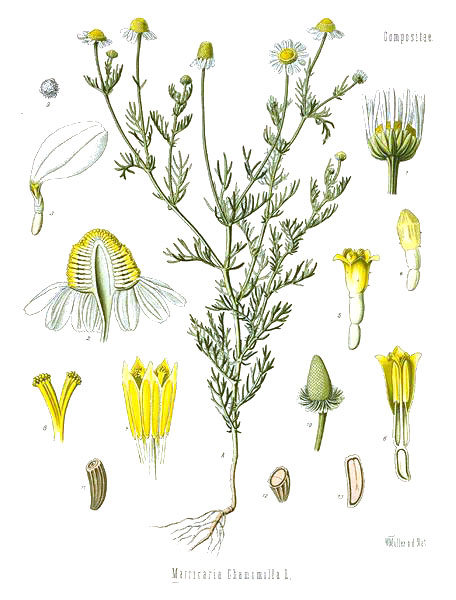German Chamomile

Origin: Europe, Northern Africa, and Asia
Scientific Name: Matricaria chamomilla (aka M. recutita)
Folk Names: Bitter chamomile, blue chamomile, camomyle, chamaimelon, corn feverfew, dog’s chamomile, ground apple, horse gowan, Hungarian chamomile, mayweed, Persian chamomile, scented mayweed, sweet false chamomile, vulgar chamomile, water of youth, wild chamomile
Related:
- Chamomile: General/shared information
- Roman Chamomile: Chamaemelum nobile
Magical
Arguments are presented for multiple (arguably conflicting) sets of correspondences for chamomile. Some argue it should be given solar associations, due to the bright colour and scent of the flowers, while others argue that its healing qualities suggest it should be associated with water and the moon. I associate Roman chamomile more strongly with water and German chamomile with solar energy.
Element: Fire
Day: Sunday
Planet: Sun
Zodiac: Leo
Associated Celebrations: Summer solstice, St. John’s Day,
(Yule)
Deities: Apollo, Balder, Cernunnos, Hekate, Hypnos, Ra, Woden
Parts used: Flowers & flowering tops
Magical Properties: Prosperity, communication, friendship, love, luck, peace, protection, purification, success, victory
Substitutions: Lavender, Roman chamomile
Lore
- German Chamomile is one of the Nine Sacred Herbs of the Anglo-Saxons. It was also used as a strewing herb to combat pests and odour.
- Chamomile is traditionally gathered on St John’s Day (June 24th). In Transylvania, it was believed that on this day, German chamomile turned into corn chamomile (Anthemis arvensis), probably due to the fact that it flowers later. In other areas, it was believed that witches flew over the herb that night, taking away all its medicinal power.
Magical Uses
- Place pressed chamomile flowers in wallet to attract money.
- Add German chamomile to incenses and potions for sleep and calm.
- German chamomile’s sunny disposition can be used to combat baneful magic.
- Wash thresholds with a chamomile infusion to keep it unwanted energies/entities.
- Wash hands in a chamomile infusion before a job interview or sales meeting to attract luck and success.
Aromatherapy
Part used: Flowers
Extraction method: Steam distillation
Flash Point: 104°C
Scent type: Floral
Perfume note: Middle/base
Scent description: Herbaceous, sweet, warm
Active Constituents: α-Bisabolol oxides (20-65%)
The essential oil of German chamomile is a dark blue colour, due to the presence of chamazulene.
Aromatherapeutic Uses
Helps achieve emotional stability, dispel anger, and with the healing of skin ailments.
Warnings:
- Avoid during pregnancy.
- Can cause skin irritation: use only in low dilutions.
- German Chamomile oil is prone to oxidation: store in a dark, airtight container, ideally refrigerated.
Medicinal
Note: This information is provided for informational purposes only, do not use any plants medicinally without consulting with an appropriate medical professional.
Medicinal Properties: Analgesic, anti-inflammatory, antispasmodic, carminative, nervine, sedative, tonic
Medicinal Uses:
Reproductive System: Chamomile tea can be used to ease digestive symptoms and nausea during pregnancy, as well as easing the pain of contractions during childbirth. It can also be used to relieve mastitis and sore nipples. Chamomile is sometimes also used to relieve menopausal symptoms.
Interactions:
- Chamomile may increase the effect of warfarin or oher anticoagulant medications.
- As chamomile can be a mild sedative, it might increase the impact of sedative medications.
- Chamomile may decrease how quickly the liver breaks down medications, and thus could impact their effectiveness.
- The estrogen in chamomile may impact on the effectiveness of contraceptive pills or other estrogen-based medications.
- Be cautious with chamomile if treating any estrogen-sensitive cancers, as it can affect estrogen levels and decrease the effectiveness of some medications.
Warnings:
- Chamomile is unsafe for those with ragweed allergies, or sensitive to other plants in the Asteraceae family.
- German chamomile should be avoided by those who have hormone-sensitive conditions due to its impact on estrogen.
Practical
See chamomile.
Botanical
German chamomile is one of 5+ species of Matricaria, all of which are annual herbs.
Type: Upright herb
Plant size: 15-60cm
Leaves: Long, narrow, branched leaves
Flowers: Small, white, daisy-like flowers
Etymology: Matricaria comes from the Latin matrix, which can mean ‘womb’, due to its use in treating gynecologic complaints such as menstrual cramps.
In the Garden
Type: Annual
Sow: Spring
Light: Full sun to partial shade
Water: Low
Soil: Well-drained
Companion Planting: German chamomile particularly enjoys the company of lavender, rosemary, and hyssop.
Tips:
- Harvest the leaves in spring and early summer.
- Harvest flowers in summer when fully open.
- Harvesting individual flowers can be incredibly labour-intensive, so it is generally easier to harvest the entire flowering tops.
